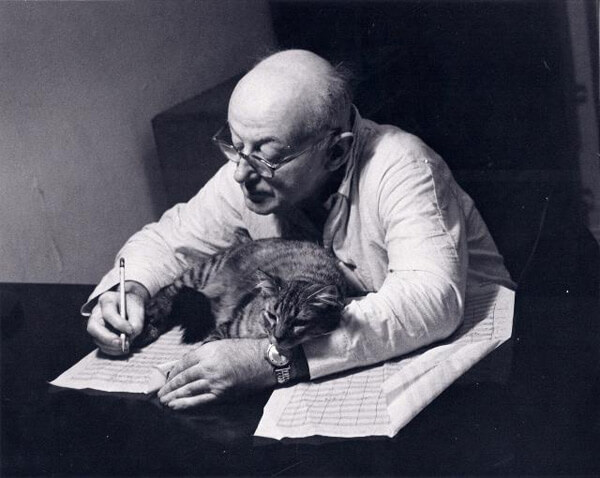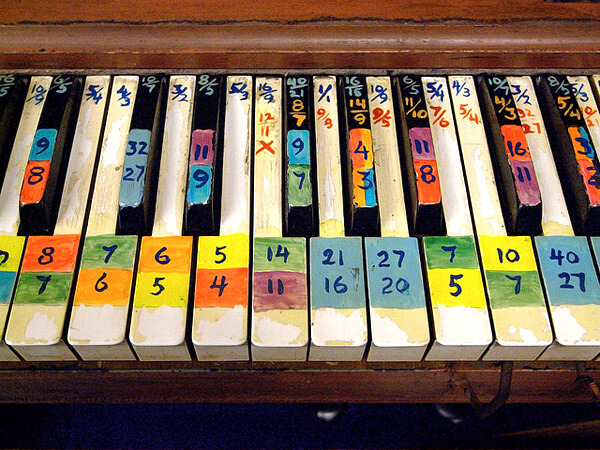 The third concert in the San Francisco Symphony’s American Marvericks series (fourth if the new Harrison documentary counts as a concert) was a very interesting program. Walking into the hall to our seats, the audience was greeted by the sight of a grand piano in the middle of a collection of some of the strangest instruments I’ve ever seen on stage at Davies Symphony Hall. There was a small crowd up near the stage taking photos—even though this was strictly forbidden by hall policies. This buzz of excitement captures well the general climate of the event. While most of the composers whose music is programed for these “mavericks” concerts are long dead, many of them are underappreciated by the general public, and many of them were true mavericks during their lifetimes. This series comes like a breath of fresh air to those grown tired of hearing the same stale programs year after year, it’s almost as though the San Francisco Symphony has decided to create a series around classics of the “new” music repertoire, sprinkled with a few premieres just for added spice.
The third concert in the San Francisco Symphony’s American Marvericks series (fourth if the new Harrison documentary counts as a concert) was a very interesting program. Walking into the hall to our seats, the audience was greeted by the sight of a grand piano in the middle of a collection of some of the strangest instruments I’ve ever seen on stage at Davies Symphony Hall. There was a small crowd up near the stage taking photos—even though this was strictly forbidden by hall policies. This buzz of excitement captures well the general climate of the event. While most of the composers whose music is programed for these “mavericks” concerts are long dead, many of them are underappreciated by the general public, and many of them were true mavericks during their lifetimes. This series comes like a breath of fresh air to those grown tired of hearing the same stale programs year after year, it’s almost as though the San Francisco Symphony has decided to create a series around classics of the “new” music repertoire, sprinkled with a few premieres just for added spice.

First on the program was a set of pieces for solo piano by Henry Cowell, a composer who grew up in Menlo Park, a few miles down the road from San Francisco. For today’s performance, the pianist was Jeremy Denk. I have long respected Denk’s playing, and was very much looking forward to hearing him perform the music of one of my favorite composers, including several works I have performed recently myself. I absolutely loved the first two pieces, Advertisement and Episode (the only piece in the set I have not played). Advertisement begins with a “cluster” that is released one note at a time, followed by a somewhat jarring waltz that slowly disintegrates into cascades of clusters played with the fists from one end of the keyboard to the other. Episode is a beautiful little piece: it got a bit of a surprised reaction from the audience, some of whom were perhaps expecting it to be less “pretty.” Denk did a fantastic job with the piece, bringing out the different simultaneous lines with great clarity. Next was The Banshee, one of Cowell’s signature works where the pianist requires an assistant to hold down the damper pedal while they sweep the strings with palms, fingers, and nails. Overall the performance was solid, although I wondered why the pizzicato notes were not played at the pitch notated, but instead down a tritone (necessitating an awkward jump over a brace). I also would have liked to hear more pitch in the pizzicati and less nail-on-string noise. After The Banshee Denk moved on to Exultation. One of my favorite pieces by Cowell, Exultation is a lilting “walking tune” in two different meters at the same time. I was left puzzled by the performance. In the second section of the work the melody moves to the tone-clusters in the right forearm. Usually one hears the melody quite clearly, in either the top or bottom note of the clusters. Denk however didn’t voice the clusters to one end or the other, and the result was a wash of bland pentatonic sound. The Cowell set finished with another standard, Aeolian Harp, this time played by silently depressing keys on the keyboard with one hand and then strumming the string with the other. As with The Banshee, I would have preferred a clearer tone in the pizzicato sections.

The second set was a group of pieces by Harry Partch, a true maverick in every sense of the word (if a Dead White Guy as well). He spent years riding the rails as a hobo during the depression, designed his own tunings (his most famous being the 43-tone scale, instead of the usual 12 semitones per octave), and build his own instruments to accommodate his complex scales. Several of those instruments made an appearance at today’s concert: the Kithara, Diamond Marimba, Cloud Chamber Bowls, Chromelodeon, Harmonic Canons, Bass Marimba, and Hypobass. Besides their abilities to play “between the cracks” of our usual scale, what makes these instruments particularly special just by themselves is Partch’s idea that his instruments should be sculptures in addition to producing musical sounds. Like Wagner and his gesamtkunstwerk, Partch envisioned an all-encompassing art form, which he dubbed “corporeal theater.” Every aspect of his music was part of the composition, from the pitches to the actions of the performers to the very instruments they performed on.
Today’s performance by the PARTCH ensemble was fascinating. As someone with perfect pitch, listening to microtonal music is something that takes getting used to, but I’ve been listening to Partch’s music for a while, and had heard several of the works performed this afternoon before. I especially liked the group’s performance of Barstow, which incorporated some acting by members of the ensemble. In addition to secure ensemble and amazing instruments that completely covered the available space on the stage in Davies Symphony Hall, there was just the right amount of humor in the performance. The audience was very receptive, and the group was clapped back onto stage for three curtain calls. The performance left me wishing I played the Chromelodeon.

Riley: the conservative on the concert. Played well, shows one of the “new classics” of the repertoire. Amongst a program of pieces for unusual instruments (or usual ones used in unusual ways), the Riley stood out almost to the point of seeming bland. The SFS members who performed the work (Dan Carlson and Amy Hiraga on violin, Jonathan Vinocour, viola, and Peter Wyrick, cello) played extremely well and worked together as an ensemble perfectly.
The final work on the program was the world premiere of Morton Subotnick’s Jacob’s Room: Monodrama. Set for solo vocalist (Joan La Barbara) with string quartet, keyboard, and electronics, the piece was an intense examination of “holocaust.” Besides drawing material from the Holocaust, it reflects on it as a more general destruction of humanity. The text draws from Virginia Woolfe’s novel Jacob’s Room, and also borrows from Nicholas Gage’s memoir Eleni, including passages about the execution of his mother during the Greek civic war. Through creative placement of microphones and the use of electronics, La Barbara’s voice was made to sound as though it came from different sources. This was especially effective in the first of two vocal cadenzas. The electronics made it sound as though there were singers (ghosts?) flying around the hall crying for justice and mercy.
All in all, I loved this concert. Partch was breathtaking, Subotnick intense, Riley being the only piece on the program to use instruments we know in a familiar way. The audience was what one might expect for a new music concert: younger than usual for typical SFS crowd, and featured much more facial hair, piercings, and bright clothing than I’ve seen in Davies in a while.
—
Kelsey Walsh is a pianist and currently resides in San Francisco. Follow her on twitter: @kwpianist
























